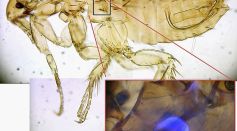Tags: Evolution
Robots are Being Taught to Autonomously Evolve to Survive in Distant Planets
Can A Single Altered Gene Turn Fish Fins into Limbs?
New Study Suggests Warmer Climates Could Create More Harmful Mutations

Study Reveals Sleep Evolved Ahead of Brain Evolution
3 Wild Instances of Evolution Replicating Itself
Study Reveals the Answer to the Humble Beginnings of Pterosaurs

New Study Examines Effect of Brain Size on Mammal Population Densities

Study of Flea Genetics Points their Position on Tree of Life and Closest Relatives
Scientists Find a Flamboyant, Chicken-Sized Dinosaur
Global Warming Now Faster Than Evolution

9,000-Year History of Corn Unveiled

Human Evolution Evidently Taking Place Among Southeast Asian Free Divers
Here’s How Humans Are Still Evolving
Experts Reveal How Insects Formed Its Wings
Plant Found In China Evolved To Become Less Visible to Humans
Scientists Used Algorithms to Explain the Origins of Life
New Lizard Species Has "Perplexing" Possible Positions in the Evolutionary Tree
Best Friends For Ages: Tracking the Partnership of Dogs and Humans
Drum Experiment Reveals Clues On Cultural Evolution
New Study Suggests That Language Started Forming 30 to 40 Million Years Ago
Most Popular

Why Stars Twinkle: Flickering Explained by Atmospheric Turbulence and Light Distortion

The Role of Materials Science in Engineering: How Modern Engineering Materials Drive Innovation

Tornadoes vs. Waterspouts vs. Dust Devils: Key Differences and Vortex Types Explained

Climate Adaptation Strategies Explained: How Societies Respond to Climate Change




